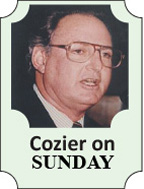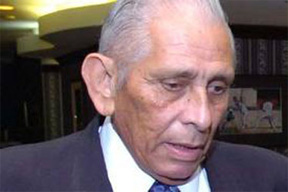THERE were all the mixed emotions so typical of such West Indian occasions. The tearful sadness at the death – unexpected and premature – of the cricketing icon that Joey Carew unquestionably was pervaded the packed congregation at his funeral service at St.Theresa’s Roman Catholic Church in Port-of-Spain on Friday morning.
The neat, modest church at which he regularly worshipped is just a stroll away from his long-time home in Woodbrook, where he was a loving husband to Marion for close to 50 years and the dedicated and much-loved head of a close-knit family.

From St.Theresa’s, family, friends, fans and former teammates, several with famous names who had flown in from distant parts, adjourned two blocks away to the Queen’s Park Oval, home of the Queen’s Park Club for 114 years, venue of international cricket since the early 1900s. This was Joey Carew’s second home.
He had spent countless joyful days on the field, as successful captain and batsman of club and country. When his playing days were over he became an administrator in the best managed sports club in the Caribbean.
Most times, he could be found at the club sharing his forthright views on cricketers and cricket and horses and horse racing, his other sporting passion.
In the short walk from St.Theresa’s to Queen’s Park on Friday, the mood inevitably changed. It was now time to recall the things that made Carew the rare individual he was.
Laughter repeatedly filled the air for, as traditional and profound as was his attitude to cricket, he had a quick wit and an impish sense of humour. A practical joke or a droll comment was seldom far away.
If many of the stories were embellished with some exaggeration, it was from memories fading with age and, of course, only for effect.
Yet the highlights of his cricket career needed no hyperbole. They remain indelible in the record books.
He was the first captain to lead his team to successive regional championships, Trinidad and Tobago reversing years of frustration to win the Shell Shield in 1970 and 1971.
His personal contribution in 1970 carried the all-round excellence of a Garry Sobers, even though he would reject the comparison with someone he held as his cricketing god.
Quite apart from his influence on his players, Carew’s assertive left-handed batting brought him 523 runs in the four matches at an average of 87.16, including hundreds in each innings against Jamaica, while his off-spin bowling, even if nondescript in the manner of a Chris Gayle, claimed 13 wickets at 9.23 runs each.

The following season, at Queen’s Park, there was the thrill of Trinidad and Tobago’s first victory over Barbados in 40 years. The placard held up by a jubilant fan in front of Barbados’ captain Sobers at the end of the match might have been written by Carew himself.
It read: “Cockroach ain’t frade (sic) fowl again, Gary”.
Carew’s most significant contribution to West Indies cricket, even above his relationship with and mentoring of the genius who was to become the highest scorer in both Test and first-class matches, was as West Indies selector.
As Lara observed, he served in that thankless capacity at separate times during four decades – the last three of the 20th century and the first of the 21st. It verified the regard in which his knowledge and objectivity were held by successive West Indies administrations.
Like all selectors, he was often accused of insularity but only by those who spoke from an insular base themselves.
That Carew accepted the call to duty every time it was made bore out his commitment to West Indies cricket. He could just as well have said he simply didn’t need the hassle that came with the job and told them just what to do with it. All that was mentioned by the assembled gathering at Queen’s Park but the humorous anecdotes were the most prevalent.
Charlie Davis, who played with Carew for the West Indies and under him for Trinidad and Tobago, remembered the captain’s instructions to medium-pacer Prince Batholemew in a Shield match against Jamaica at Sabina Park. They were not to give Maurice Foster, a master off the pads, anything to hit through the leg-side.
When Bartholomew went for boundaries through square-leg off his first three balls, Carew came up to him and said: “Oh, now I see, you like the shot!” He was quickly taken off but Foster made a hundred all the same.
My own fondest Carew memories were from the 1968-69 tour of Australia and New Zealand. He had missed out of the famous 1960-61 tour in spite of a strong record for Trinidad and Tobago and, in the interim, been twice to England, in 1963 and 1966.
Each time, he struggled against the moving ball and in weather he didn’t appreciate.
He couldn’t understand how the game originated in such a damp, cold climate; Australia, with its sunshine and its great grounds and facilities and its true pitches, was how he envisaged cricketing heaven.
It showed in his returns – 683 runs at an average of 48.78 in the eight Tests (five in Australia, three in New Zealand where his 109 in the victory in Auckland was his only Test hundred).
The combined trip lasted five and a half months. Carew and fast bowler Richard ‘Prof’ Edwards especially helped to lighten it up with their constant humour. It was well before ODIs, Packer and the like.
Instead, it entailed visits to small towns in the Australian outback like Kalgoolie, Murgon, Mackay and Mildura simply to fly the flag of international cricket.
There would be a one-day match against a combined country team and the regulation mayoral reception at which team members would be introduced to the assembled dignitaries by identifying themselves to the liveried official at the door who would then present them, one by one.
So, for instance, it was a whispered Garfield Sobers for the introduction, “Ladies and Gentleman, Mr. Garfield Sobers”. And so on.
Carew, typically Joey, put a different twist to the parade. He gave an assortment of names so that the guests would be astonished, and then loudly amused, to hear: “Ladies and Gentlemen, Mr.Christopher Columbus” or “Mr. Marlon Brando”.
Until, that is, he passed himself off as “Elvis Presley” and heard the announcement: “Ladies and Gentlemen, there is a cricketer here who thinks he’s Elvis Presley”. The whole room, the team and, after he had collected himself, Joey burst into laughter.
After that, he was always Joey Carew. No, life was ever dull when he was around.
When Australian captain Bill Lawry refused to enforce the follow-on in the final Test in spite of a lead of 340, Carew reckoned it was against the spirit of the game – as did Lawry’s deputy Ian Chappell and most other observers. Joey’s response was to ask captain Sobers to place all the fielders on the off-side and he would serve up his straight off-spin feet wide.
“But Joey that would be killing the game,” Sobers told him.
“Lawry’s killed it already,” was Carew’s succinct comment.
Sobers did relent partially, placing one man on the leg-side so that Carew sent down five eight-ball overs to a 9-1 field. That wit was there even when he had to have his leg removed just days before his death.
Dinanath Ramnarine related that when he visited him in hospital he quipped that he would now have to play everything on the backfoot.
Deryck Murray said he told him that, before this, he thought he had come through the worst in life by facing Charlie Griffith and Wes Hall on a fast pitch at Kensington. There are those who will remember Joey Carew for many things.
My most enduring recollections are from that tour of Australia and New Zealand, from Trinidad and Tobago’s signal victory over Barbados in 1971 and from our many tete-a-tetes on the ups and downs of West Indies cricket over the past 40 years or so.




